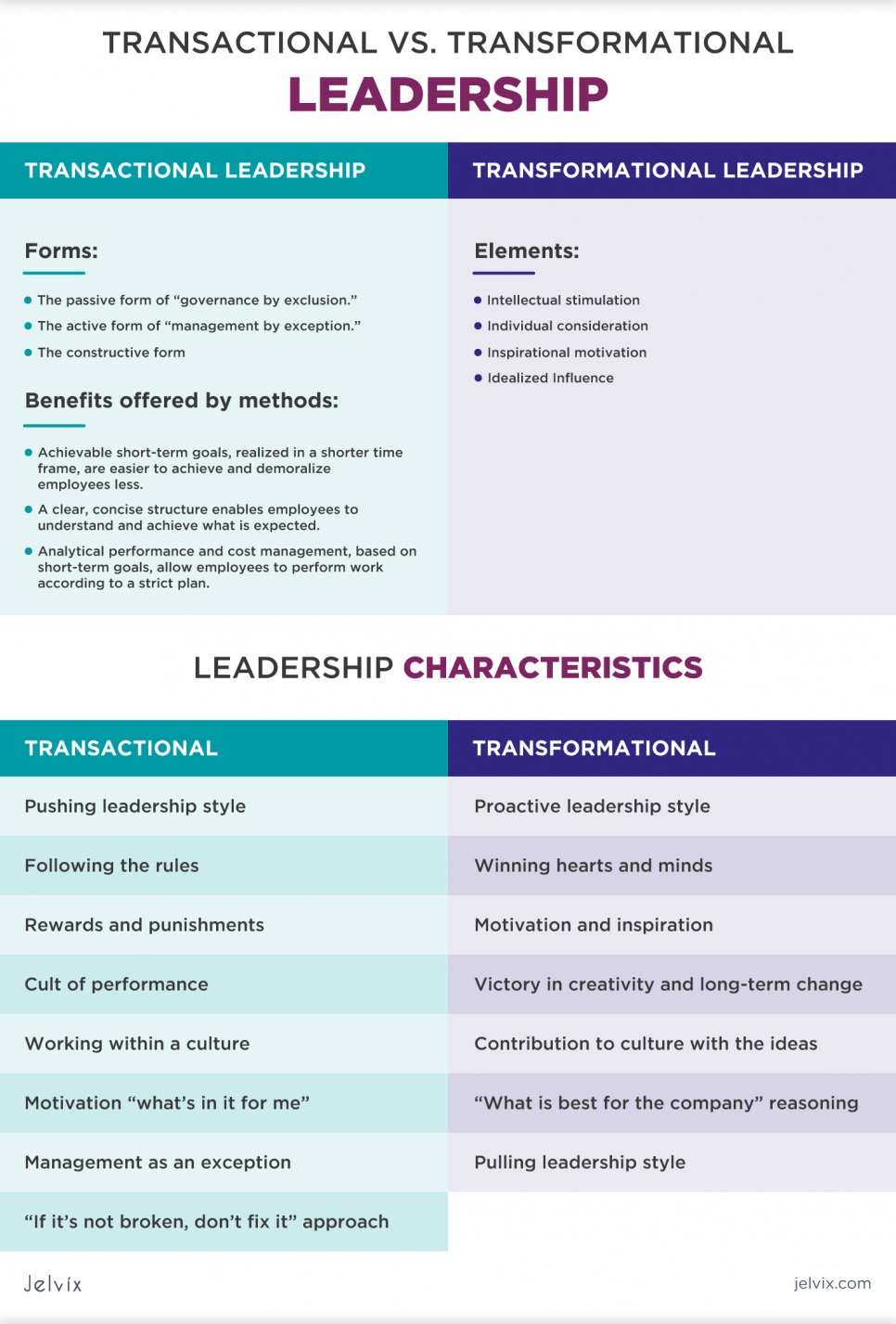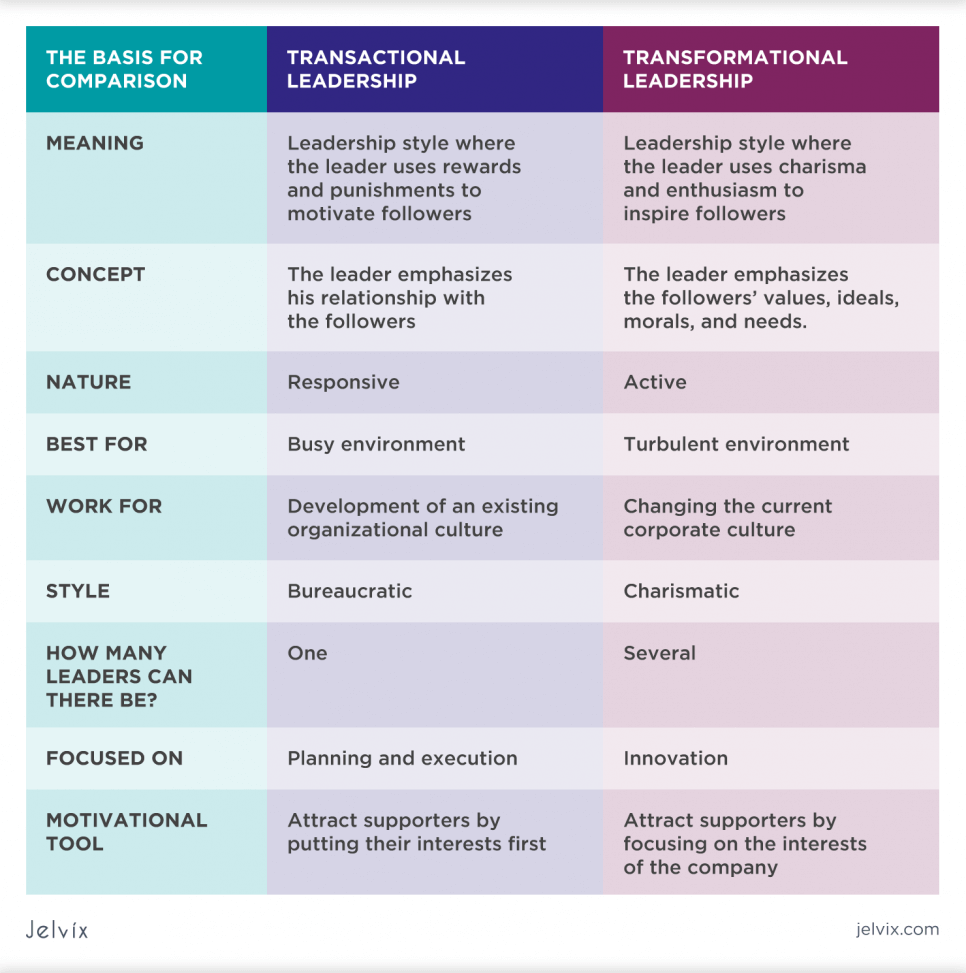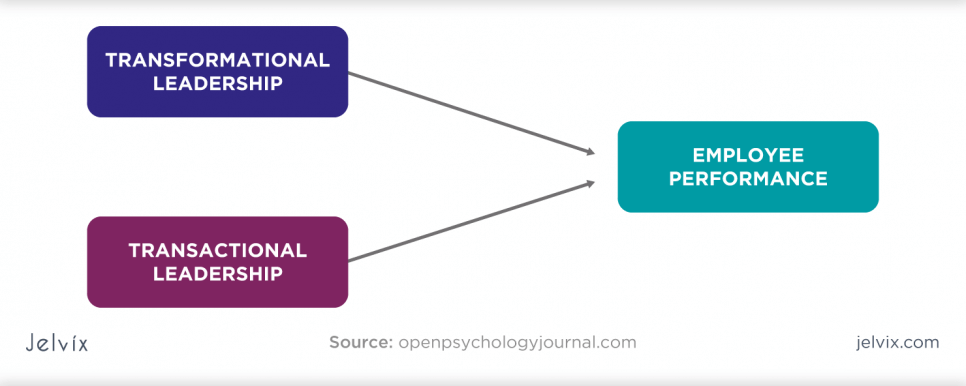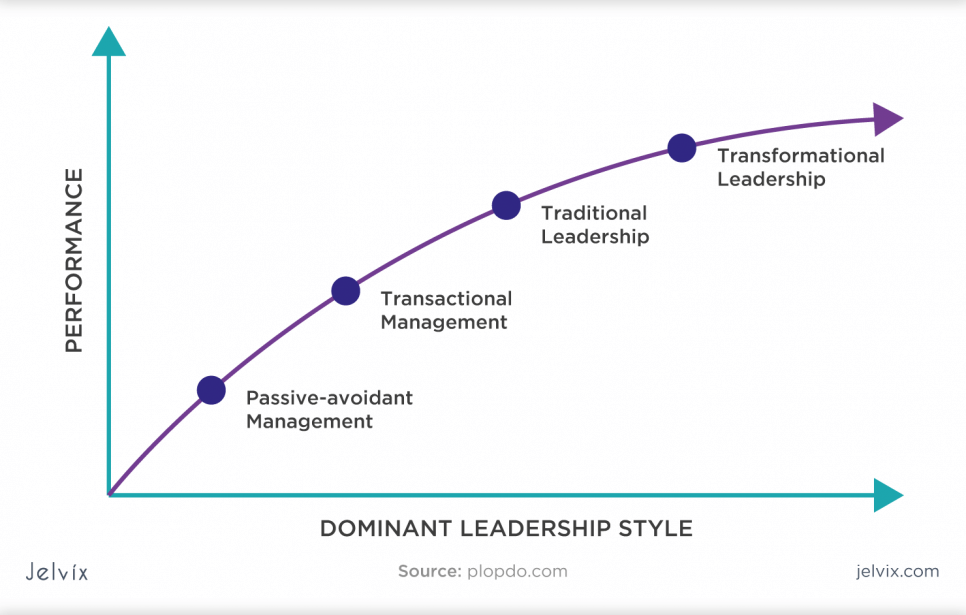Leadership is the ability to manage people’s behavior to achieve the organization’s goals. How a leader achieves these goals depends on the style of leadership, which determines the desired result.
We will look at two of them – transactional vs. transformational leadership. While the approaches are opposite, both have benefits that are important for creating positive change and growth. If you aspire to leadership in the business world, you must understand the difference between them and learn how to apply or combine them depending on the situation.
What is Transactional Leadership?
Transactional leadership is a more structured management approach based on rigorous checks and balances throughout a company’s life cycle. The style follows the philosophy of reinforcement and exchange – managing employees by setting specific tasks and subsequent material rewards for their achievements. In addition, employees are granted a certain degree of autonomy within company policy if they can achieve their goals effectively and on time.
According to transactional leadership theory, this is a variant of a “deal” in which the transactional leader acts based on “give and take,” punishment and reward, and command and control. Hierarchy is important, and employees know who the boss is in the house.
Forms of transactional leadership
There are three forms of transactional leadership:
- The passive form of “governance by exclusion.” In this transactional leadership style, the leader sets goals and only intervenes if those goals have not been met or if problems arise.
- The active form of “management by exception.” In this form, the transactional leader monitors progress and makes adjustments when called for.
- The constructive form. The leader articulates his expectations. He praises what is going well and shares suggestions, tips, and feedback. This style of transactional leadership is considered the most effective.
Most people can become such leaders because all they have to do is work within the policies and procedures of the organization and make sure that their direct subordinates do what is required of them. They meet no objection; people do what they are told because it is part of their job.
On the one hand, transactional management encourages employees to work harder because they are well-rewarded. However, on the other hand, they cannot focus on the purpose, meaning, and motivating factors.
When is transactional leadership effective?
Transactional leadership is appropriate when it must carry out tasks, procedures, work, projects, and policies in a certain way with no deviation. Benefits offered by transactional leadership methods include:
- Achievable short-term goals, realized in a shorter time frame, are easier to achieve and demoralize employees less.
- A clear, concise structure enables employees to understand and achieve what is expected.
- Analytical performance and cost management, based on short-term goals, allow employees to perform work according to a strict plan.
Transactional leaders are frequently found in manufacturing, where workers must complete a set production quota per shift. Another area where transactional thinking can benefit is sales, as the team strives to achieve specific goals and results.
It can also be most effective in situations where there are tight time constraints for project execution and when financial resources are limited. Also, transactional leadership is most consistently manifested in the armed forces, where each soldier has a specific rank and specific duties.
The model works best with self-motivated employees who do not need inspiration from top managers or company leaders, making this leadership approach popular in established companies.
Transactional leadership characteristics:
- Pushing leadership style
- Following the rules
- Rewards and punishments
- Cult of performance
- Working within a culture
- Motivation “what’s in it for me”
- Management as an exception
- “If it’s not broken, don’t fix it” approach
Transactional leadership examples
While these leaders may not have had a purely transactional approach, they are known for their commitment to rigorous processes and control:
- Steve Jobs. The “father” of Apple’s most influential products and concepts, Jobs ruled with an iron fist and showed tangible results. His desire for control remains clear in the very structure of Apple products, which operates within tight limits.
- Bill Belichick. This fast-paced NFL coach based his style on Sun Tzu’s “The Art of War.” His rigorous top-down approach has brought many trophies to Lombardi.
What is Transformational Leadership?
This leadership style works well in organizations or teams where the goals include developing employees’ talents rather than just meeting production quotas or sales purposes. Transformational leaders are focused on personal and professional growth and encourage all employees to think creatively while looking for solutions to longstanding problems.
This aligns with Agile’s work, as teams need a leader to help and inspire them. Such a leader challenges the existing order by being open to possibilities, thinking outside the box, and tolerating deviant ideas.
What are the elements of transformational leadership?
The transformational leadership style is based on four components, commonly referred to as the four “I’s”:
- Intellectual stimulation: encouraging new experiences and ways of thinking for yourself and your employees;
- Individual consideration: mentoring employees and supporting their professional development;
- Inspirational motivation: conveying the organization’s vision that employees learn and create independently;
- Idealized Influence: being a role model for desired high-performing behavior.
As a detail of the four “I’s,” transformational leaders focus on positively motivating and nurturing their employees. Instead of micromanaging, transformational leaders organize an independent workspace that encourages creativity and innovative thinking and gives employees space to make their own decisions.
When is transformational leadership effective?
Transformational leadership may be the preferred approach in an environment where a product or service is new or in an industry where innovation is the key to survival.
With a new product or start-up company, the “rules” and processes are not set yet, and innovative thinking about producing, growing, and thriving can be necessary and even expected.
Transformational leaders can be the most effective by leading young employees. The leader acts as a role model and a motivator who offers vision, excitement, support, morale, and satisfaction to the followers.
It offers a way to bring organizations to a much higher energy level to achieve completely different outcomes. Nokia, which has grown from a timber merchant to a world leader in mobile communications, is a textbook example of possible! Transformational leadership involves a keen vision and a passion for realizing the dream.
Transformational leadership characteristics
- Proactive leadership style
- Winning hearts and minds
- Motivation and inspiration
- Victory in creativity and long-term change
- Contribution to culture with the ideas
- “What is best for the company” reasoning
- Pulling leadership style
Transformational leadership examples
While transactional leadership still dominates the corporate world, large organizations are increasingly adding elements of a transformational approach. Specific examples of transformational leaders include:
- Many successful people exhibit more than one leadership style, and Bill Gates is no exception. He achieved results through structure, organization, and consistently high standards with his subordinates. While there are elements of transactional leadership in Gates’ unique approach, he seeks to inspire his employees with the power of intellectual stimulation as a transformational leader. Interestingly, in the early years of Microsoft, Bill Gates had an autocratic leadership style to ensure the company grew at the pace that he had envisioned.
- Elon Musk. His success, first and foremost, depends on his unique approach to leadership. From tackling problems head-on and embracing failure to forgoing meetings whenever possible, these are the strategies Musk is known to apply daily at all of his companies.
Transactional versus Transformational Leadership: Which is Better?
Is there one correct leadership style? A comparison between transformational and transactional leadership shows that neither approach is “better” than the other, and despite obvious differences, they are not mutually exclusive.
Leadership Effectiveness
Both transactional and transformational leadership are efficient in achieving the intended results.
- Transactional leaders focus on organizational effectiveness and employee control. These leaders are not looking to innovate in the future but are looking for maximum performance in the present. They focus on ensuring that the day-to-day activities of the organization run smoothly.
- Transformational leaders focus on organizational change and employee development. These leaders spend more time developing a strategy for the future of their team or organization and then motivating and inspiring employees to share that vision. This leadership is most effective in organizations or groups that need a leader to guide them towards positive change.
Promoting innovation and creativity
A ”Frontiers in Psychology” research found that transactional leadership causes employees to “perceive the culture as more purposeful than innovative.”
In turn, transformational leadership forces employees to view organizational culture as more innovative. The style has obvious benefits for facilitating growth, innovation, and creativity in individuals, teams, and organizations.
Employees feel encouraged to develop as professionals by expanding their skills and knowledge base. It gives them purpose and meaning in their work and helps them develop their skills and achieve more than they thought possible.
Approach to motivation
An essential component of transactional and transformational leadership is motivation and how different methods can stimulate and engage employees.
- Transactional leadership uses extrinsic motivation – this is when employees are motivated to receive rewards (for example, salary, positive reviews, job opportunities, etc.) or avoid punishment.
- Transformational leadership refers to intrinsic motivation when people are motivated because they find it personally beneficial.
Of these two types, intrinsic motivation is the strongest motivator in the long run.
Similarities between transactional and transformational leadership
The parallel between transactional and transformational leadership is that they are part of the same leadership mode: the full-blown leadership model. They provide answers to how to manage groups of subordinates and use psychological methods developed and tested.
When used correctly, both methods are very effective. Both involve leaders and followers with the common goal of benefiting from each other; both are motivational in their practices, and both leadership styles have inherent goals in mind. However, they achieve results in different ways.
Differences between transformational and transactional leadership
Motivating, rewarding, and punishing team members are part of the major differences between transformational and transactional leadership. To compare the two styles in terms of reward, let’s look at two different exchanges between a leader and their followers.
- Transactional leadership revolves around low-level exchanges. These are simple exchanges that are easy to detail. They are concrete and can mostly be specified in writing. Salaries, holidays, work hours, benefits, etc., are low-level exchanges between leaders and followers.
- Transformational leadership is the opposite and focuses on high-level exchanges – a more abstract interaction between two parties. These exchanges are difficult to define and measure: trust, personal commitment, loyalty, support, protection, acceptance, and other unique things.
However, low-level and high-level exchanges can occur simultaneously if both styles are used under the same conditions as the same leader.
Here are a few key differences between transactional and transformational leadership:
- Transactional leadership responds to problems as they arise, while transformational leadership is more likely to solve problems before they become critical.
- Transactional leaders work within the existing organizational culture, while transformational leaders emphasize new ideas and “transform” the corporate culture.
- Transactional leaders reward and punish according to organizational standards; transformational leaders encourage investment in projects, which leads to a high-order internal reward system.
- Transactional leaders appeal to employees’ self-interest and those who seek personal rewards, while transformational leaders appeal to group interests and ideas of organizational success.
- Transactional leadership is more like a general idea of management, while transformational leadership is more closely related to leadership.
- Unlike transactional leadership, transformational leadership is not just about rewarding good behavior. A transformational leader creates a motivating process that automatically leads to good behavior.
- The transactional leadership style suits leaders with little authority, while leaders with charisma and influence use transformational leadership best.
| The basis for comparison | Transactional Leadership | Transformational Leadership |
|---|---|---|
| Meaning | Leadership style where the leader uses rewards and punishments to motivate followers | Leadership style where the leader uses charisma and enthusiasm to inspire followers |
| Concept | The leader emphasizes his relationship with the followers | The leader emphasizes the followers’ values, ideals, morals, and needs. |
| Nature | Responsive | Active |
| Best for | Busy environment | Turbulent environment |
| Work for | Development of an existing organizational culture | Changing the current corporate culture |
| Style | Bureaucratic | Charismatic |
| How many leaders can there be? | One | Several |
| Focused on | Planning and execution | Innovation |
| Motivational tool | Attract supporters by putting their interests first | Attract supporters by focusing on the interests of the company |
How Transactional and Transformational Leadership complement each other
When developing, adapting, and applying these two leadership styles, it is important to consider both the advantages and disadvantages of each and the current work situation in your team and organization. A leader may naturally gravitate toward either the transactional or transformational side of their style and methods. However, an effective leader understands that both models need to be integrated into their overall leadership tools.
Traditional or transactional leadership operates at a behavioral level as a type of imposed or, at best, a negotiated contract between leader and followers. While this is the best approach for maximizing operational efficiency, transactional leadership can fail in innovation, long-term strategy, and employee development.
Transformational leadership functions at the level of being. This new type of leadership does not eliminate the need for transactional leadership, just as quantum physics does not obliterate Newtonian physics. The best leaders are good on both fronts.
While transformational leadership is best suited to create a strategy and drive organizational change, it sometimes lacks attention to detail. These leaders are less concerned with day-to-day workflow and processes. It also depends on the type of leader who can maintain great motivation and passion for a long period.
It is not possible to replace transactional leadership with transformational leadership: employees will still need to be rewarded for their actions. But transformational leadership with transactional characteristics remains the best style.
Conclusion
When motivating staff, the most effective way is to balance transformational and transactional leadership (freedom and discipline). Ideally, a visionary, transformational leader should be at the organization’s helm, and a few managers who manage mid-level employees can use a transactional style.
But, it shouldn’t always be the default choice for every team or project. For example, a project with many rigid processes or compliance requirements probably wouldn’t benefit from the out-of-the-box thinking of transformational leadership.
You, too, can motivate your team during difficult times and successfully lead them through the transformation to positive change through transactional vs. transformational leadership. What’s more, you can discover situational leadership, which allows you to adjust and adapt your style to deliver what the situation requires. Contact us to know what you can do to make your organizational change successful.




















